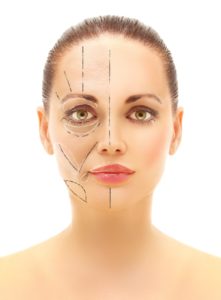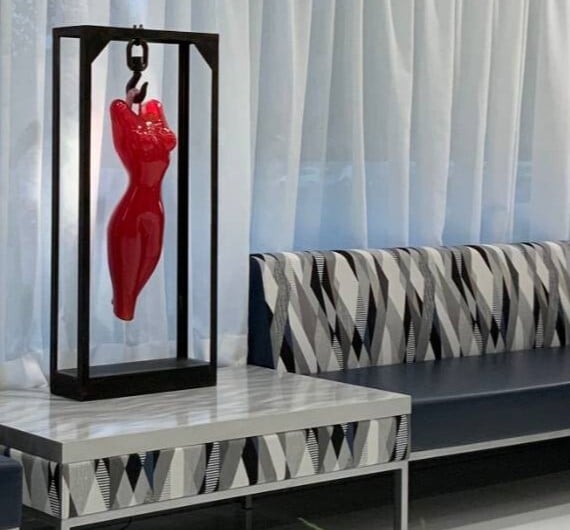Patients love the concept of fat grafting — taking fat from unwanted areas, such as the lower abdomen or outer thighs, and injecting in into areas of the face that have lost volume. Fat grafting can be a great way to add volume to sunken cheeks or to fill out smile or lip lines. Dr. Epstein performs fat grafting in his practice. This page is all about facial fat grafting. To read about fat grafting for the buttocks and breasts, head to this page.
What is facial fat grafting?
Fat grafting is a three-step procedure. Unwanted fat is harvested from an area such as the abdomen, upper thighs, or the flanks. The fat cells are separated from the accompanying fluids and purified. Then those cells are injected back into the area that needs volume. Dr. Epstein uses facial fat grafting on the cheeks, under the eyes, nasolabial folds, areas with acne scars, among others. Because the injected fat was produced by the patient’s own body originally, reactions or rejection don’t happen.

Am I a candidate for facial fat grafting?
Dr. Epstein uses fat grafting on the face to return volume to laugh lines, smile lines, crow’s feet, under eye hollows, sunken cheeks, the lips, and to correct acne scarring.
Obviously, beyond needing volume returned to various areas, you also need to have fat to harvest. This is usually taken from the abdomen, upper thighs, or flanks.
However, fat grafting isn’t for everyone. If a patient has too much loose skin, a facelift may be a better procedure.
What Problems Does Facial Fat Grafting Treat?
Fat grafting procedures are popular for several reasons. One is that the use of your body's own fat cells can treat a number of soft-tissue defects with minimal discomfort and downtime. With age, the shape of the face changes due to inconsistency in the replenishment of vital proteins and substances like elastin and hyaluronic acid. As the integrity of the skin, fat, and muscle declines, you may notice several effects, including hollowing in critical areas like the jowls, cheeks, and temples. Dr. Epstein utilizes fat to reduce hollowing and improve the overall shape of the face. Some of the specific concerns for which fat grafting may be a good solution include:
- Sunken temples or eyes
- Loss of volume across the forehead
- Deep horizontal lines on the forehead
- Frown lines
- Tear trough deformity resulting in undereye bags
- Nasolabial creases between the nose and mouth
- Marionette lines between the corners of the mouth and the chin
- Thin, deflated lips
- Weak chin
- Jowls
What Are the Benefits of Facial Fat Grafting?
Every patient that we meet has their own reasons for choosing facial fat grafting. In addition to being a versatile soft tissue filler, your body's extra fat serves as a fully biocompatible filler. We take fat from your body, separate fat from other fluids, then reintroduce the pure fat to areas of your face that can benefit from enhancement. There is no chance that your body will react adversely to this filler. Longevity is the other primary benefit of facial fat grafting. After the injected fat settles and begins receiving its own blood supply, your results can last many years.
How Can I Prepare for Facial Fat Grafting?
During your consultation for facial fat grafting, we will discuss all of the risks and benefits associated with this procedure. After this appointment, you should have no lingering questions about what to expect (if you do, call us!). In between your consultation and your fat grafting procedure, you may need to stop smoking and alter the use of certain medications. To get the best, longest-lasting results of facial fat grafting, it is necessary to also be at your ideal weight. This is the weight that is right for you; a weight that you intend to maintain for many years. The reason for this pre-treatment recommendation is that your fat cells respond to your weight, even the fat cells that contour your face. Gaining or losing a fair amount of weight could compromise your fat grafting results.
How Long Will the Results Last?
It takes some time for the results of facial fat grafting to settle. For up to about six weeks, some of the transferred fat can get reabsorbed back into the body. Those that do integrate, which is usually well over half, start to behave in the same manner as surrounding fat tissue. The fat that lives on remains in place for many years, if not indefinitely.
Are Facial Fat Grafting Results Permanent?
The fat that develops blood supply in the augmented areas of the face can remain there indefinitely. This does not mean that the results of facial fat grafting are permanent. We tend to refer to them as semi-permanent because, though the fat stays in place, it is not protected from the aging process. The benefit of facial fat grafting is that the introduction of fat cells into certain areas can minimize your current aging symptoms. Over time, though, inevitable tissue changes may diminish the effects of this procedure.
What Makes Facial Fat Grafting Different from Similar Procedures?
Facial fat grafting is usually considered a long-term alternative to soft tissue fillers. The process itself is more involved; the doctor must extract some fat cells from a part of your body to accomplish natural facial rejuvenation, and there may be a bit of downtime. With dermal fillers, you can go right back to most normal activities as only one part of your body, your face, is treated. Dermal fillers are convenient and have a lower up-front cost. However, the effects of treatment tend to last an average of 12 to 18 months, sometimes up to two years, before repeat injections are needed. If you're interested in exploring a long-term option for facial contouring and rejuvenation, we're happy to discuss the options that would be appropriate for you.
How is fat grafting done?
This is a three-step procedure.
1. Harvesting
Your unwanted fat is harvested from the donor site. Once selected, Dr. Epstein uses tumescent liposuction to remove the fat from the area. First a saline solution that also contains lidocaine and epinephrine is injected into the area. This acts to constrict the fat pockets, making them easier to remove. Plus, the lidocaine acts as a local anesthetic and the epinephrine constricts blood vessels for less blood loss and bruising.
2. Purification
Once the fat is removed, the fat cells are separated from the blood, tissue, and other fluids. The purified fat is then ready to be injected back into the target areas.
3. Placement
The purified fat is now injected into the target areas with a thin cannula. As Dr. Epstein withdraws the cannula from an injection site, a line of fatty tissue cells is deposited. In larger areas such as the cheeks, he may create a grid of grafted fat. Otherwise, for areas such as smile lines, the line may simply follow the crease in the skin. In most cases, the grafted areas are then lightly massaged to provide a natural contour.
When will I see my facial fat grafting results?
After your fat transfer, you will have swelling and the fat cells need to acquire blood supply from vessels in the area. Those that successfully connect to blood vessels will “take.” Other fat cells will not take, and will die and be flushed from the body by the lymphatic system. The amount of fat injected that will take is variable. Fat tends to take better in areas with more muscle. Fat grafts, on average, have a 60 percent survival rate, so Dr. Epstein will inject more fat than is needed in the target area.
You will also have swelling that will take a few weeks to fully resolve.
During your early weeks after your fat grafting session, the increase in volume is due mainly to swelling. But as that resolves, within 2-4 months, you may seem to lose a little volume. This is because the fat grafts aren’t fully healthy yet. As the grafts successfully take, you will see your final results, usually from 3-4 months after your session. These results can continue to improve for even a few more months after that.
What are the risks involved with facial fat transfer?
Because you’re having your own fat injected back into your face, reactions don’t happen. Otherwise, risks are as with any surgical procedure, reaction to anesthesia, bleeding, infection, changes in nerves sensation, and the like. These are rare with fat grafting.
Some patients find that over time their bodies absorb much of the grafted fat. This is not true of a majority of patients and the amount of fat that takes vs what doesn’t varies widely. Dr. Epstein’s expertise in handling and injecting the fat is important here. Dr. Epstein performs fat transfers for the breast, buttocks, the backs of the hands, and across the face. He has extensive experience, which can make a huge difference in the final results, including the amount of fat that successfully takes.
Schedule A Consultation
For more information on Facial Fat Grafting, call 631.689.1100 or contact us online to schedule a consultation with Dr. Epstein. Our practice serves Hauppauge, Long Island, and surrounding areas in New York.


